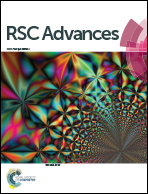Methanol oxidation on Ru(0001) for direct methanol fuel cells: analysis of the competitive reaction mechanism†
Abstract
The competitive oxidation reaction mechanism of methanol on the Ru(0001) surface has been investigated by periodic density functional theory (DFT). Stable adsorption configurations, elementary reaction energies and barriers, the potential energy surface (PES), and the electrochemical potential analysis were elucidated. The results showed that O–H bond activation was more competitive than C–H and C–O bond activation during the initial methanol oxidation. Competitive pathways occurred for CH3OH oxidation to CH2O via CH3OH → CH3O → CH2O versus CH3OH → CH2OH → CH2O, further to COOH via the CO pathway CH2O → CHO → CO → COOH versus the non-CO pathway CH2O → CH2OOH → CHOOH → COOH, and finally oxidation to CO2. Taking PES and the electrochemical potential analysis into account, CH3OH → CH2OH → CH2O → CH2OOH → CHOOH → COOH → CO2 appeared to be the preferred oxidation pathway. The OH group could inhibit CO formation by directly reacting with CH2O to yield CH2OOH but could not efficiently remove the CO that had already been produced by the reactions.


 Please wait while we load your content...
Please wait while we load your content...